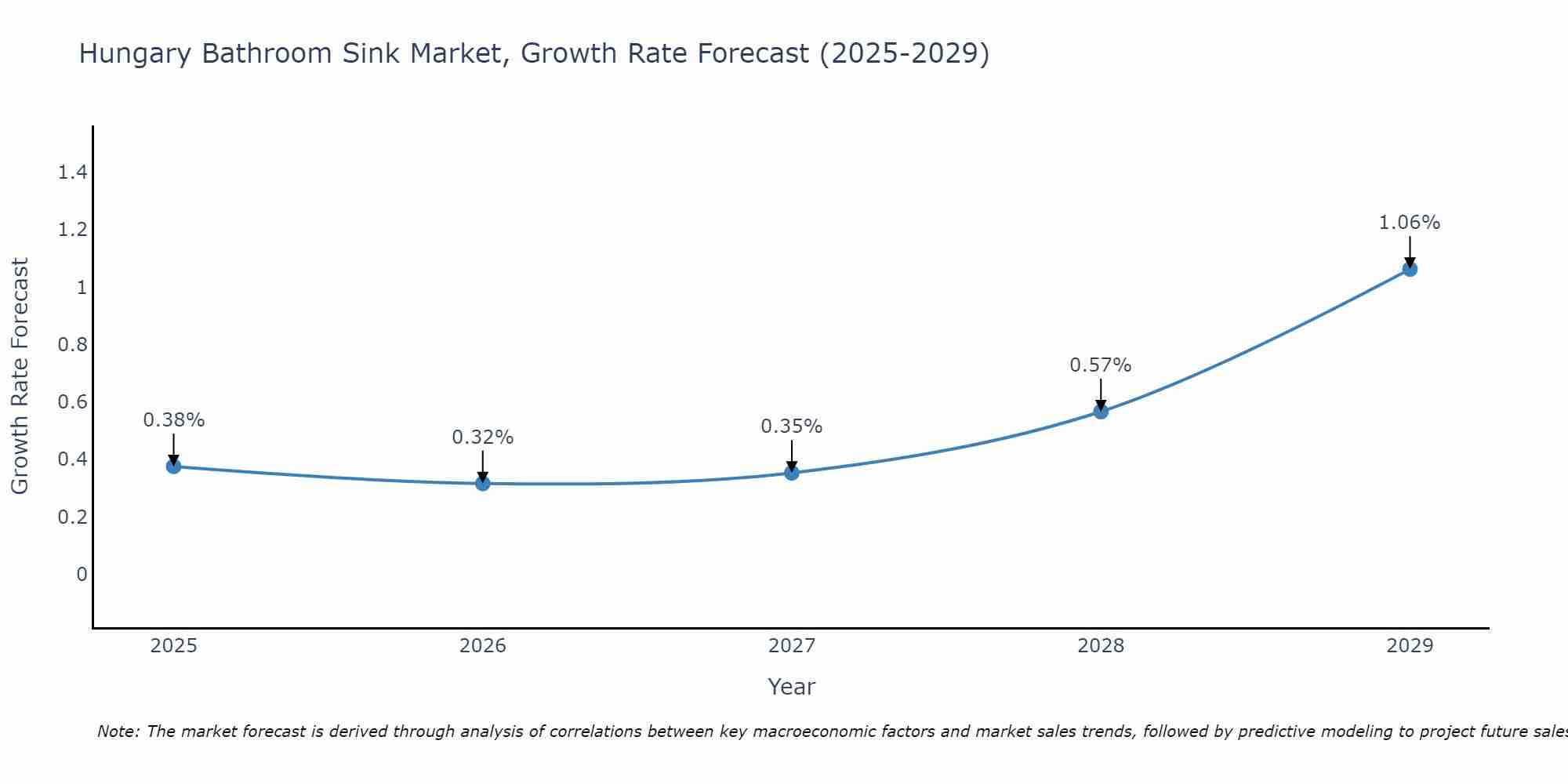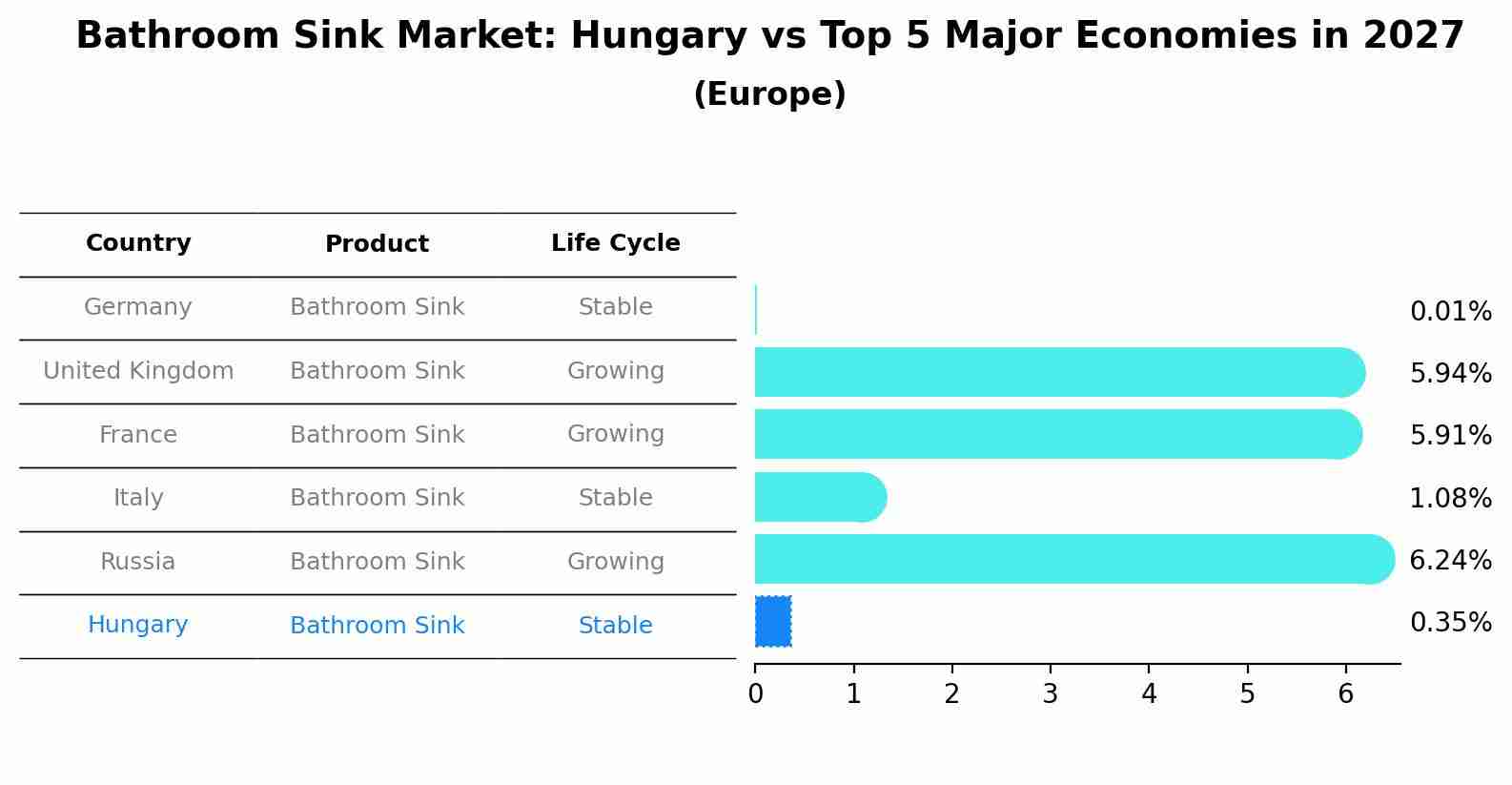Hungary Bathroom Sink Market Outlook | Trends, Share, Forecast, Growth, Revenue, Size, Companies, Analysis, Industry, COVID-19 IMPACT & Value
| Product Code: ETC375079 | Publication Date: Aug 2022 | Updated Date: Apr 2025 | Product Type: Market Research Report | |
| Publisher: 6Wresearch | No. of Pages: 75 | No. of Figures: 35 | No. of Tables: 20 | |
Hungary Bathroom Sink Market Size Growth Rate
The Hungary Bathroom Sink Market is projected to witness mixed growth rate patterns during 2025 to 2029. From 0.38% in 2025, the growth rate steadily ascends to 1.06% in 2029.

Bathroom Sink Market: Hungary vs Top 5 Major Economies in 2027 (Europe)
By 2027, the Bathroom Sink market in Hungary is anticipated to reach a growth rate of 0.35%, as part of an increasingly competitive Europe region, where Germany remains at the forefront, supported by United Kingdom, France, Italy and Russia, driving innovations and market adoption across sectors.

Hungary Bathroom Sink Market Overview
Hungary bathroom sink market is witnessing growth propelled by factors such as increasing urbanization, rising disposable income, and changing consumer preferences for aesthetically pleasing and functional bathroom fixtures. Manufacturers are innovating with materials, designs, and technologies to cater to evolving consumer demands.
Drivers of the market
The Hungary Bathroom Sink market is primarily driven by factors such as increasing construction activities, renovation projects, and rising disposable incomes. As the housing and construction sectors continue to grow in Hungary, there is a parallel increase in demand for bathroom fixtures and fittings, including sinks. Additionally, changing consumer preferences towards stylish and innovative bathroom designs fuel the demand for premium and customized bathroom sinks. Moreover, advancements in sink materials and technologies, such as the use of eco-friendly materials and water-saving features, contribute to market expansion.
Challenges of the market
Intense competition from imported products, especially from neighboring countries, poses a challenge for domestic manufacturers in the Hungary bathroom sink market. Additionally, fluctuations in construction activity and consumer spending affect market demand.
Government Policy of the market
The Hungary government focuses on promoting sustainable practices in the construction and housing sectors, including the use of water-efficient fixtures such as bathroom sinks. Building codes and regulations mandate the installation of water-saving sinks in new construction projects and renovation initiatives to reduce water consumption and promote environmental conservation. Additionally, the government offers incentives such as tax credits and subsidies to encourage homeowners and businesses to upgrade to water-efficient bathroom sinks, thereby fostering market demand for eco-friendly plumbing products.
Key Highlights of the Report:
- Hungary Bathroom Sink Market Outlook
- Market Size of Hungary Bathroom Sink Market, 2021
- Forecast of Hungary Bathroom Sink Market, 2028
- Historical Data and Forecast of Hungary Bathroom Sink Revenues & Volume for the Period 2018 - 2028
- Hungary Bathroom Sink Market Trend Evolution
- Hungary Bathroom Sink Market Drivers and Challenges
- Hungary Bathroom Sink Price Trends
- Hungary Bathroom Sink Porter's Five Forces
- Hungary Bathroom Sink Industry Life Cycle
- Historical Data and Forecast of Hungary Bathroom Sink Market Revenues & Volume By Product for the Period 2018 - 2028
- Historical Data and Forecast of Hungary Bathroom Sink Market Revenues & Volume By Under-mount Sinks for the Period 2018 - 2028
- Historical Data and Forecast of Hungary Bathroom Sink Market Revenues & Volume By Top-mount Sinks for the Period 2018 - 2028
- Historical Data and Forecast of Hungary Bathroom Sink Market Revenues & Volume By Pedestal Sinks for the Period 2018 - 2028
- Historical Data and Forecast of Hungary Bathroom Sink Market Revenues & Volume By Vessel Sinks for the Period 2018 - 2028
- Historical Data and Forecast of Hungary Bathroom Sink Market Revenues & Volume By Integrated Sink and Countertops for the Period 2018 - 2028
- Historical Data and Forecast of Hungary Bathroom Sink Market Revenues & Volume By Semi recessed Sinks for the Period 2018 - 2028
- Historical Data and Forecast of Hungary Bathroom Sink Market Revenues & Volume By Wall-mounted Sinks for the Period 2018 - 2028
- Historical Data and Forecast of Hungary Under-mount Sinks Bathroom Sink Market Revenues & Volume By Washplane Sinks for the Period 2018 - 2028
- Historical Data and Forecast of Hungary Bathroom Sink Market Revenues & Volume By Application for the Period 2018 - 2028
- Historical Data and Forecast of Hungary Bathroom Sink Market Revenues & Volume By Residential for the Period 2018 - 2028
- Historical Data and Forecast of Hungary Bathroom Sink Market Revenues & Volume By Non-residential for the Period 2018 - 2028
- Hungary Bathroom Sink Import Export Trade Statistics
- Market Opportunity Assessment By Product
- Market Opportunity Assessment By Application
- Hungary Bathroom Sink Top Companies Market Share
- Hungary Bathroom Sink Competitive Benchmarking By Technical and Operational Parameters
- Hungary Bathroom Sink Company Profiles
- Hungary Bathroom Sink Key Strategic Recommendations
Frequently Asked Questions About the Market Study (FAQs):
- Single User License$ 1,995
- Department License$ 2,400
- Site License$ 3,120
- Global License$ 3,795
Search
Related Reports
- ASEAN Bearings Market (2025-2031) | Strategy, Consumer Insights, Analysis, Investment Trends, Opportunities, Growth, Size, Share, Industry, Revenue, Segments, Value, Segmentation, Supply, Forecast, Restraints, Outlook, Competition, Drivers, Trends, Demand, Pricing Analysis, Competitive, Strategic Insights, Companies, Challenges
- Europe Flooring Market (2025-2031) | Outlook, Share, Industry, Trends, Forecast, Companies, Revenue, Size, Analysis, Growth & Value
- Saudi Arabia Manlift Market (2025-2031) | Outlook, Size, Growth, Trends, Companies, Industry, Revenue, Value, Share, Forecast & Analysis
- Uganda Excavator, Crane, and Wheel Loaders Market (2025-2031) | Strategy, Consumer Insights, Analysis, Investment Trends, Opportunities, Growth, Size, Share, Industry, Revenue, Segments, Value, Segmentation, Supply, Forecast, Restraints, Outlook, Competition, Drivers, Trends, Demand, Pricing Analysis, Competitive, Strategic Insights, Companies, Challenges
- Rwanda Excavator, Crane, and Wheel Loaders Market (2025-2031) | Strategy, Consumer Insights, Analysis, Investment Trends, Opportunities, Growth, Size, Share, Industry, Revenue, Segments, Value, Segmentation, Supply, Forecast, Restraints, Outlook, Competition, Drivers, Trends, Demand, Pricing Analysis, Competitive, Strategic Insights, Companies, Challenges
- Kenya Excavator, Crane, and Wheel Loaders Market (2025-2031) | Strategy, Consumer Insights, Analysis, Investment Trends, Opportunities, Growth, Size, Share, Industry, Revenue, Segments, Value, Segmentation, Supply, Forecast, Restraints, Outlook, Competition, Drivers, Trends, Demand, Pricing Analysis, Competitive, Strategic Insights, Companies, Challenges
- Angola Excavator, Crane, and Wheel Loaders Market (2025-2031) | Strategy, Consumer Insights, Analysis, Investment Trends, Opportunities, Growth, Size, Share, Industry, Revenue, Segments, Value, Segmentation, Supply, Forecast, Restraints, Outlook, Competition, Drivers, Trends, Demand, Pricing Analysis, Competitive, Strategic Insights, Companies, Challenges
- Israel Intelligent Transport System Market (2025-2031) | Strategy, Consumer Insights, Analysis, Investment Trends, Opportunities, Growth, Size, Share, Industry, Revenue, Segments, Value, Segmentation, Supply, Forecast, Restraints, Outlook, Competition, Drivers, Trends, Demand, Pricing Analysis, Competitive, Strategic Insights, Companies, Challenges
- Uganda Precast and Aggregate Market (2025-2031) | Strategy, Consumer Insights, Analysis, Investment Trends, Opportunities, Growth, Size, Share, Industry, Revenue, Segments, Value, Segmentation, Supply, Forecast, Restraints, Outlook, Competition, Drivers, Trends, Demand, Pricing Analysis, Competitive, Strategic Insights, Companies, Challenges
- Australia IT Asset Disposal Market (2025-2031) | Strategy, Consumer Insights, Analysis, Investment Trends, Opportunities, Growth, Size, Share, Industry, Revenue, Segments, Value, Segmentation, Supply, Forecast, Restraints, Outlook, Competition, Drivers, Trends, Demand, Pricing Analysis, Competitive, Strategic Insights, Companies, Challenges
Industry Events and Analyst Meet
Our Clients
Whitepaper
- Middle East & Africa Commercial Security Market Click here to view more.
- Middle East & Africa Fire Safety Systems & Equipment Market Click here to view more.
- GCC Drone Market Click here to view more.
- Middle East Lighting Fixture Market Click here to view more.
- GCC Physical & Perimeter Security Market Click here to view more.
6WResearch In News
- Doha a strategic location for EV manufacturing hub: IPA Qatar
- Demand for luxury TVs surging in the GCC, says Samsung
- Empowering Growth: The Thriving Journey of Bangladesh’s Cable Industry
- Demand for luxury TVs surging in the GCC, says Samsung
- Video call with a traditional healer? Once unthinkable, it’s now common in South Africa
- Intelligent Buildings To Smooth GCC’s Path To Net Zero













